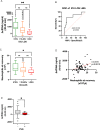A prospective cohort study of dynamic cell-free DNA elevation during cardiac surgery with cardiopulmonary bypass
- PMID: 36301964
- PMCID: PMC9612555
- DOI: 10.1371/journal.pone.0276443
A prospective cohort study of dynamic cell-free DNA elevation during cardiac surgery with cardiopulmonary bypass
Erratum in
-
Correction: A prospective cohort study of dynamic cell-free DNA elevation during cardiac surgery with cardiopulmonary bypass.PLoS One. 2024 Dec 30;19(12):e0316868. doi: 10.1371/journal.pone.0316868. eCollection 2024. PLoS One. 2024. PMID: 39774427 Free PMC article.
Abstract
Cardiac surgery and cardiopulmonary bypass (CPB) are associated with a systemic inflammatory reaction that occasionally induces a life-threatening organ dysfunction caused by the dysregulated host response to the damage-associated molecular patterns (DAMPs). In severe inflammation, cell-free DNA (cfDNA) and histones are released by inflammatory cells and damaged tissue and act as DAMPs. We sought to characterize the changes in circulating cell-free DNA (cfDNA) levels during CPB. Primary outcomes were renal failure, ventilation time (>18 hr), length of stay (LOS) in the intensive care unit (ICU) (>48hr), hospital LOS (>15 days), and death. We looked for associations with blood tests and comparison to standard scores. In a prospective cohort study, we enrolled 71 patients undergoing non-emergent coronary artery bypass grafting. Blood was drawn at baseline, 20 and 40 minutes on CPB, after cross-clamp removal, and 30 minutes after chest closure. cfDNA was measured by our fast fluorescent method. Baseline cfDNA levels [796 (656-1063) ng/ml] increased during surgery, peaked after cross-clamp removal [2403 (1981-3357) ng/ml] and returned to baseline at recovery. The difference in cfDNA from 20 to 40 minutes on CPB (ΔcfDNA 40-20) inversely correlated with peripheral vascular disease (PVD), longer ventilation time, and longer ICU and hospital length of stay (LOS). Receiver operating characteristic (ROC) curve of ΔcfDNA 40-20 for long ICU-LOS (>48hr) was with an area under the curve (AUC) of 0.738 (p = 0.022). ROC AUC of ΔcfDNA 40-20 to long Hospital LOS (>15 days) was 0.787 (p = 0.006). Correction for time on CPB in a multivariate logistic regression model improved ROC-AUC to 0.854 (p = 0.003) and suggests that ΔcfDNA 40-20 is an independent risk factor. To conclude, of measured parameters, including STS and Euroscore, the predictive power of ΔcfDNA 40-20 was the highest. Thus, measurement of ΔcfDNA 40-20 may enable early monitoring of patients at higher risk. Further studies on the mechanism behind the negative association of ΔcfDNA 40-20 with PVD and outcomes are warranted.
Conflict of interest statement
NO authors have competing interests
Figures




References
-
- Squiccimarro E, Labriola C, Malvindi PG, Margari V, Guida P, Visicchio G, et al.. Prevalence and Clinical Impact of Systemic Inflammatory Reaction After Cardiac Surgery. Journal of cardiothoracic and vascular anesthesia. 2019;33(6):1682–90. Epub 20190117. doi: 10.1053/j.jvca.2019.01.043 . - DOI - PubMed
-
- Avriel A, Paryente Wiessman M, Almog Y, Perl Y, Novack V, Galante O, et al.. Admission cell free DNA levels predict 28-day mortality in patients with severe sepsis in intensive care. PLoS One. 2014;9(6):e100514. Epub 2014/06/24. doi: 10.1371/journal.pone.0100514 [pii]. ; PubMed Central PMCID: PMC4067333. - DOI - PMC - PubMed
Publication types
MeSH terms
Substances
LinkOut - more resources
Full Text Sources
Medical

